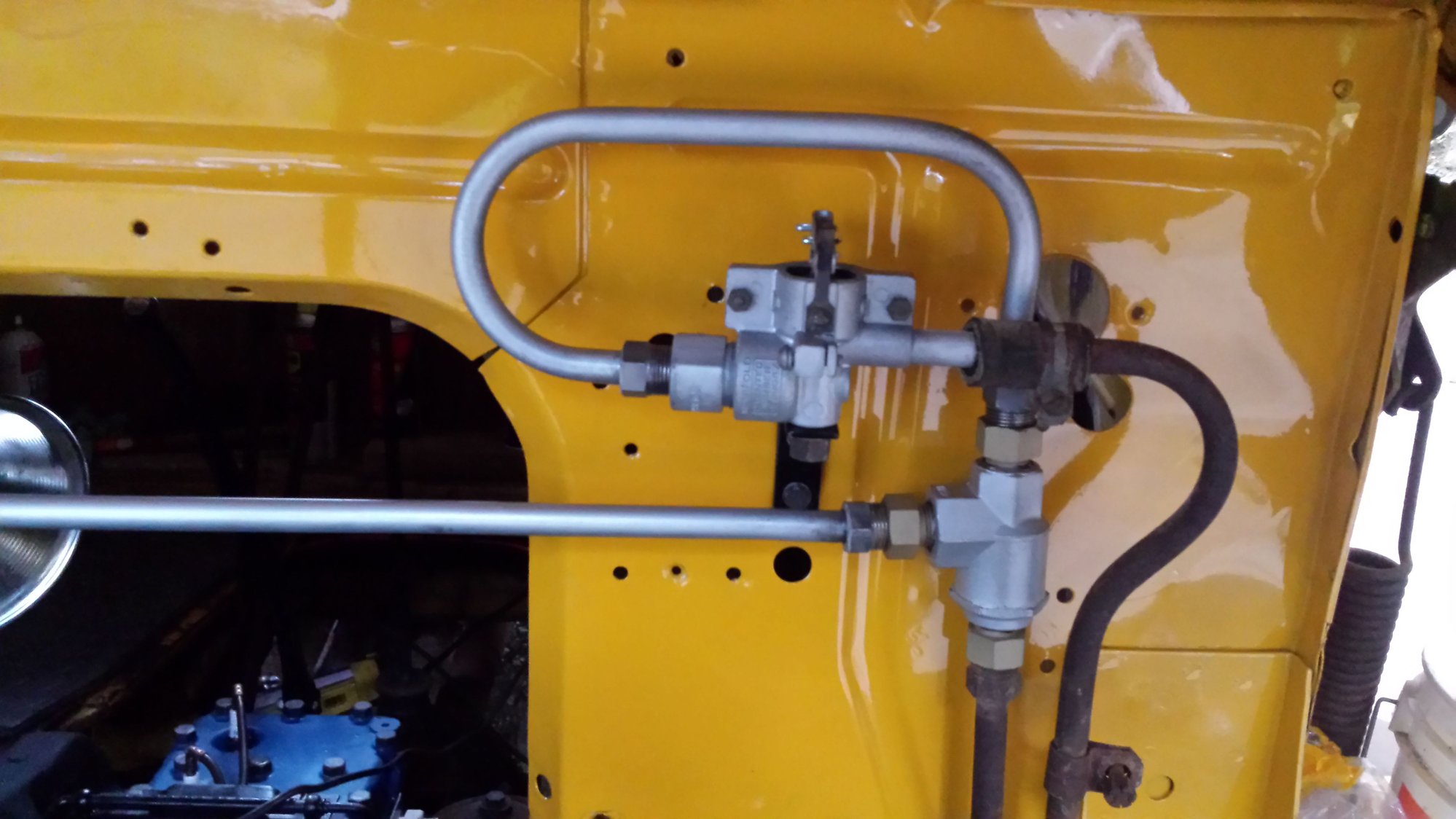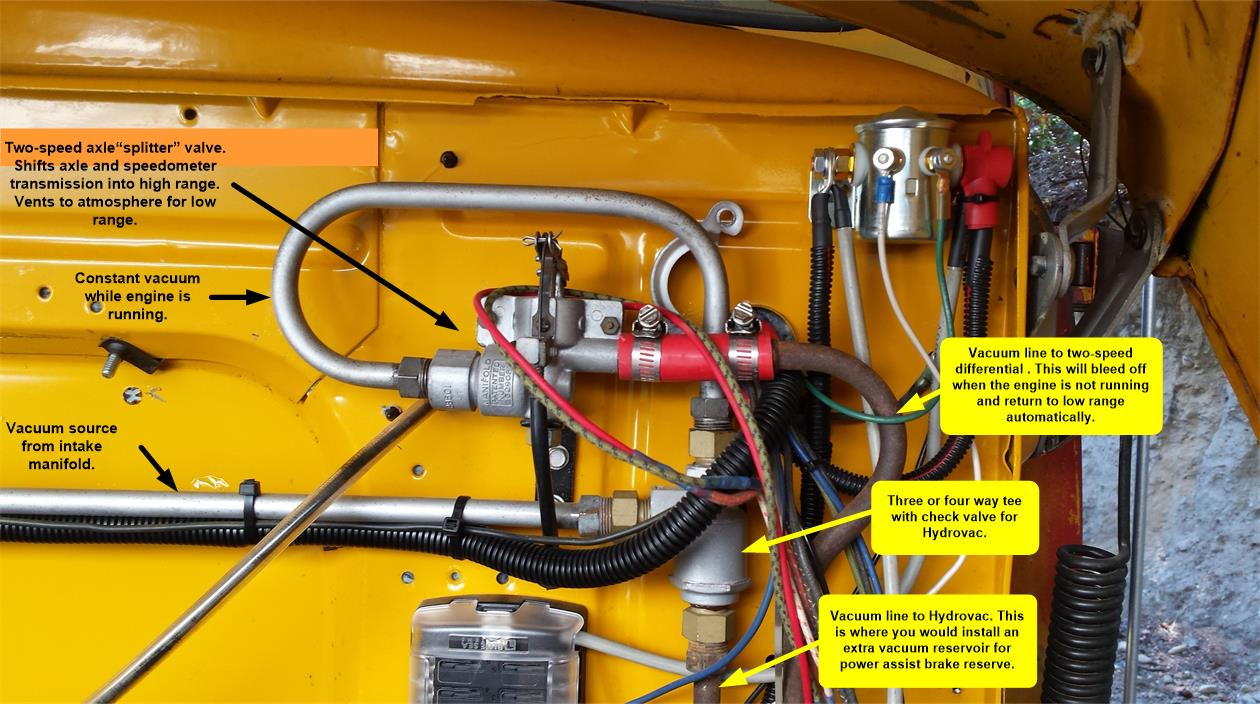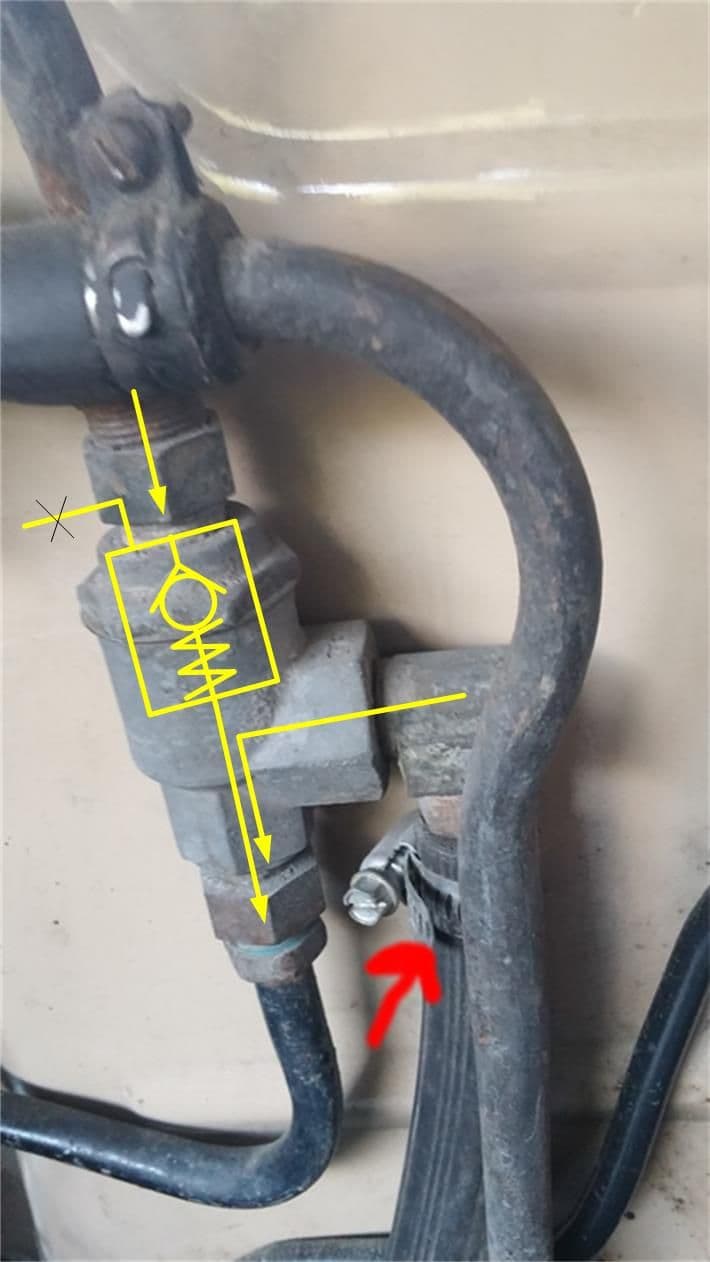1948 Ford F6 two speed rear end - High/Low
#1
1948 Ford F6 two speed rear end - High/Low
I have a two speed rear axle and I'm not sure what the added tank is for. My shop manual doesn't show this configuration. I haven't been able to get my truck into high gear and I was wondering what is this tank and is it needed.
Should I revert it back to what the manual shows?
Thank you.
Should I revert it back to what the manual shows?
Thank you.
#2
Personally I would leave it extra cubic inches of vac. is a good thing. Not shifting?
Have you taken the chamber off and see if moves in and out? If it moves in with no
leaks put it back on -truck running control button out (high) and tap the shift arm
with hammer see if it moves, make sure there's no load on the axle so jack up one
wheel. If it doesn't move, guess you have to dig in the axle more. Did it ever work?
you have a manual so study the planetary gear set up quite simple maybe its just the
shift arm a little stuck where it goes thru the housing.
Have you taken the chamber off and see if moves in and out? If it moves in with no
leaks put it back on -truck running control button out (high) and tap the shift arm
with hammer see if it moves, make sure there's no load on the axle so jack up one
wheel. If it doesn't move, guess you have to dig in the axle more. Did it ever work?
you have a manual so study the planetary gear set up quite simple maybe its just the
shift arm a little stuck where it goes thru the housing.
#3

That's an old C02 fire extinguisher. If it were me, I'd get a more appropriate chamber such as an air tank from a truck with air brakes (wrecking yard). On my truck, that tee on the firewall is much different, it actually mounts to the firewall and has another tap inside the cab. The two rusty tubes go to the two-speed shifter diaphragm and the Hydrovac.
#4
Nice yellow wall, I believe the inside of the truck? Strange. Mine is in the engine compartment. Do you have a picture of your underside? I'd like to see your setup on the hi/lo and additional tank.
I haven't done so, but I was thinking that I should take the tank off and configure it as per my manual.
I haven't tested the chamber yet. I'm looking for leaks this week.
Thanx for the replies.
I haven't done so, but I was thinking that I should take the tank off and configure it as per my manual.
I haven't tested the chamber yet. I'm looking for leaks this week.
Thanx for the replies.
#5
Nice yellow wall, I believe the inside of the truck? Strange. Mine is in the engine compartment. Do you have a picture of your underside? I'd like to see your setup on the hi/lo and additional tank.
I haven't done so, but I was thinking that I should take the tank off and configure it as per my manual.
I haven't tested the chamber yet. I'm looking for leaks this week.
Thanx for the replies.
I haven't done so, but I was thinking that I should take the tank off and configure it as per my manual.
I haven't tested the chamber yet. I'm looking for leaks this week.
Thanx for the replies.
#6
Well I took the time last night and disconnected the secondary line with the tank. And made the system represent closer to the manual.
The good news is that the rear end gear lever moves and isn't frozen, in which I believe it is in good shape as I was told the rear end was rebuilt about 3-4 years ago.
Following the procedure in the manual I was able to see the lever pull in (move to high) but in the little time to jump out of the truck after turning the engine off I saw it slowly creep back to low.
So I thought it could be:
1.) Vacuum leaks (though I changed out most of the lines).
2.) The diaphragm needs replaced.
3.) the engine isn't pulling enough vacuum. But the engine purrs and seams good.
I'm hoping #2, but what do you think?
Does it need the tank?
Is there an affordable vacuum leak tester?
Thank you.
The good news is that the rear end gear lever moves and isn't frozen, in which I believe it is in good shape as I was told the rear end was rebuilt about 3-4 years ago.
Following the procedure in the manual I was able to see the lever pull in (move to high) but in the little time to jump out of the truck after turning the engine off I saw it slowly creep back to low.
So I thought it could be:
1.) Vacuum leaks (though I changed out most of the lines).
2.) The diaphragm needs replaced.
3.) the engine isn't pulling enough vacuum. But the engine purrs and seams good.
I'm hoping #2, but what do you think?
Does it need the tank?
Is there an affordable vacuum leak tester?
Thank you.
#7
Trending Topics
#8
#10
#11
How can the manual's testing procedure work then. If the engine is turned off then it would lose vacuum and revert it back to Low.
The manual states for the vacuum test that it should hold it in high with the engine off. And if it relieves itself back to low that would be a decrease, thus meaning a fail with a vacuum leak? This test couldn't be performed if the vacuum was lost when the engine turns off.
Also, why is there a vacuum line to the speedometer? And what does it do. (is it to adjust the speed measurement for the hi/low rear end?)
Thank you for the pictures and explanation. This is new to me.
Thank you.
The manual states for the vacuum test that it should hold it in high with the engine off. And if it relieves itself back to low that would be a decrease, thus meaning a fail with a vacuum leak? This test couldn't be performed if the vacuum was lost when the engine turns off.
Also, why is there a vacuum line to the speedometer? And what does it do. (is it to adjust the speed measurement for the hi/low rear end?)
Thank you for the pictures and explanation. This is new to me.
Thank you.
#12
Ok, I went out because I was now curious and this time I left the engine on while performing the test.
The hi/low axle arm pulls in about 1/2-1" and stays until I turn the engine off.
Does that sound about right for movement. I can measure tomorrow, it too dark now.
That would mean that the engine must remain on.
Thank you.
The hi/low axle arm pulls in about 1/2-1" and stays until I turn the engine off.
Does that sound about right for movement. I can measure tomorrow, it too dark now.
That would mean that the engine must remain on.
Thank you.
#14
How can the manual's testing procedure work then. If the engine is turned off then it would lose vacuum and revert it back to Low.
The manual states for the vacuum test that it should hold it in high with the engine off. And if it relieves itself back to low that would be a decrease, thus meaning a fail with a vacuum leak? This test couldn't be performed if the vacuum was lost when the engine turns off.
Also, why is there a vacuum line to the speedometer? And what does it do. (is it to adjust the speed measurement for the hi/low rear end?)
Thank you for the pictures and explanation. This is new to me.
Thank you.
The manual states for the vacuum test that it should hold it in high with the engine off. And if it relieves itself back to low that would be a decrease, thus meaning a fail with a vacuum leak? This test couldn't be performed if the vacuum was lost when the engine turns off.
Also, why is there a vacuum line to the speedometer? And what does it do. (is it to adjust the speed measurement for the hi/low rear end?)
Thank you for the pictures and explanation. This is new to me.
Thank you.
I don't see how that factory test would work either, in reality. I would install a gas tight valve and a vacuum gauge where the engine vacuum line goes into the tee, start the engine and let the vacuum normalize on the gauge. Then shut off the valve, and then the engine. Watch the gauge. This part I agree with - "if it holds vacuum for ten minutes, it's good to go". This is testing the entire integrity of the secondary vacuum system.



